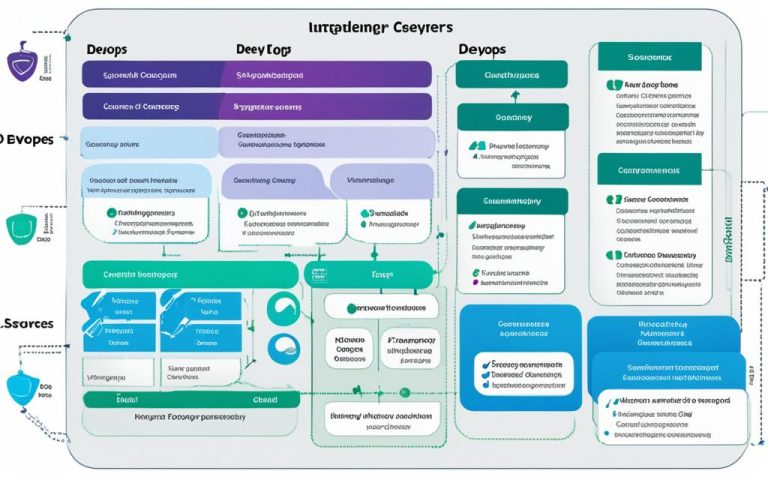Fault management is a critical aspect of network management that ensures optimal performance, reliability, and efficiency of cloud networks. By utilizing fault management tools, businesses can proactively optimize cloud performance, minimize downtime, and prevent potential disruptions that may lead to business losses.
Network fault management follows a four-step cycle: detect, isolate, alert, and resolve. It is the first line of defense in ensuring network availability and preventing device failures. The ISO’s FCAPS model recognizes fault management as one of the five core functional areas of proactive network management.
With the increasing reliance on cloud networks for business operations, the importance of network fault management cannot be overstated. According to a survey conducted by Gartner, the average cost of network downtime for enterprises is approximately $5,600 per minute. This emphasizes the need for businesses to invest in robust fault management tools to minimize downtime, maintain optimal network availability, and protect their revenue.
In the following sections, we will explore the importance of network fault management, the process of detecting and isolating network faults, the role of alerts and notifications in fault management, the resolution of network faults, and the benefits of using a comprehensive fault management tool like OpManager.
Importance of Network Fault Management
Network faults are inevitable in any IT infrastructure, and resolving these issues quickly is crucial in minimizing downtime and ensuring optimal network availability. According to a survey conducted by Gartner, network downtime costs enterprises an average of $5,600 per minute, highlighting the significant impact of network faults on business operations and revenue.
Network fault management plays a vital role in identifying, isolating, and troubleshooting network faults efficiently and effectively. By promptly detecting and resolving these issues, businesses can minimize downtime, prevent device failures, and maintain optimal network availability. This is essential for mitigating potential business losses and ensuring uninterrupted operations.
OpManager, a leading network fault management system, provides organizations with the tools and capabilities to detect, recover, and limit the impact of failures in their network infrastructure. With OpManager, businesses can proactively monitor their network, detect faults in real-time, and take immediate action to resolve them.
By investing in a robust network fault management solution like OpManager, organizations can:
- Minimize downtime and maximize productivity
- Prevent potential business losses
- Ensure optimal network availability
- Enhance the overall reliability of their network infrastructure
With its comprehensive set of features and intuitive interface, OpManager enables network administrators to efficiently manage and respond to network faults, reducing downtime and improving the overall performance of their IT infrastructure.
Network fault management is a critical component of modern IT operations, and organizations must prioritize its implementation to safeguard their network availability, protect their business revenue, and ensure seamless operations.
Costs of Network Downtime
| Duration of Downtime | Estimated Cost |
|---|---|
| 1 minute | $5,600 |
| 1 hour | $336,000 |
| 1 day | $8,064,000 |
Table: Costs of Network Downtime
As shown in the table above, even a short period of network downtime can result in substantial financial losses for businesses. By implementing an effective network fault management strategy and utilizing tools like OpManager, organizations can mitigate these risks and maintain optimal network performance.
Detecting and Isolating Network Faults
The first step in network fault management is detecting and isolating network faults. This process involves constantly monitoring networks for faults, such as performance degradation or service interruptions. Fault detection can be done through active monitoring, which involves real-time checks of device status, or passive monitoring, which captures events after they have occurred. Once a fault is detected, it is important to isolate it and focus only on actionable faults.
OpManager, a network fault management system, utilizes methods like deduplication, correlation, and automation to effectively isolate and resolve faults. OpManager’s fault management system provides comprehensive fault detection capabilities, ensuring that all potential faults are promptly identified and addressed.
By implementing OpManager’s fault management system, network administrators gain access to an advanced toolset that streamlines the fault detection and isolation process. This enables them to proactively address network issues and prevent potential disruptions.
The Fault Detection and Isolation Process
- Constant monitoring of networks for faults, such as performance degradation or service interruptions.
- Active monitoring through real-time checks of device status or passive monitoring that captures events after they have occurred.
- Focusing only on actionable faults by isolating them from non-actionable issues.
- Utilizing methods like deduplication, correlation, and automation to effectively resolve faults.
OpManager’s fault management system employs an intelligent fault detection and isolation process that enhances network reliability and minimizes downtime. This ensures that network administrators can promptly address and resolve any issues that may arise.
| Fault Detection and Isolation Benefits | OpManager’s Fault Management System |
|---|---|
| Minimizes network downtime | Yes |
| Enhances network reliability | Yes |
| Promotes proactive fault resolution | Yes |
| Optimizes network performance | Yes |

Alerting and Notifying Network Admins
Once actionable faults have been isolated, it is crucial to promptly alert and notify network administrators about the issues. Effective communication plays a vital role in ensuring timely resolution of network faults and minimizing any potential impact on the network infrastructure.
OpManager, a comprehensive network fault management tool, offers a range of alerting mechanisms to keep network admins informed. These mechanisms include:
- Visual Fault Representation: OpManager provides color-coded alarms and intuitive dashboards that visually represent network faults, enabling admins to quickly assess the severity and prioritize their response.
- Web Alarms: With OpManager’s web alarm feature, network admins receive real-time notifications and alerts directly on their web interface, ensuring they are aware of any critical issues as soon as they occur.
In addition to these alerting mechanisms, OpManager allows for seamless integration with popular trouble ticketing systems like ServiceDesk Plus, Jira, or ServiceNow. This integration streamlines issue management by automatically creating trouble tickets for identified faults, ensuring that no issue goes unnoticed or unaddressed.
Furthermore, OpManager lets network admins set up notification profiles that define the preferred channels for receiving alerts. These channels can be customized to suit the admins’ preferences, including email, SMS, or mobile app notifications. By tailoring the notification profiles, network admins can ensure that they receive alerts through their preferred medium, allowing for immediate attention and action.
“Effective alerting and notification are critical components of fault management in network infrastructure. They empower network admins with the information they need to proactively address and resolve network faults, thereby minimizing downtime and optimizing network performance and reliability.”
– Network Management Expert
By alerting and notifying network admins through various channels, OpManager ensures that critical faults are promptly addressed, preventing potential disruptions and safeguarding network performance and reliability.
| Alerting Mechanism | Description |
|---|---|
| Visual Fault Representation | Color-coded alarms and intuitive dashboards for quick fault assessment. |
| Web Alarms | Real-time notifications and alerts directly on the web interface. |
| Trouble Ticketing Integration | Seamless integration with popular trouble ticketing systems. |
| Notification Profiles | Customizable notification channels, such as email, SMS, or mobile app. |
Why Effective Alerting and Notification Matter
Effective alerting and notification are essential for network administrators to stay informed about critical faults and take prompt action. By promptly alerting admins through visual representations, web alarms, and trouble ticketing integration, OpManager empowers network admins to proactively manage network faults, minimizing downtime and optimizing network performance and reliability.
Resolving Network Faults
Resolving network faults requires a combination of automation and manual intervention. OpManager’s fault management tool simplifies and streamlines this process, ensuring efficient fault resolution and minimizing network downtime.
Automation for Efficient Resolution
OpManager automates the resolution process by running scripts and workflows that restore services and keep the network running smoothly. This automation plays a crucial role in dropping unwarranted events, reverting alarm status, and suppressing known alarms. By automating routine tasks, OpManager’s fault management tool enables faster fault resolution, enhancing network performance and efficiency.
Manual Intervention for Quick Solutions
Despite automation, there are instances where manual intervention is necessary for troubleshooting and implementing quick solutions. OpManager provides built-in web-based troubleshooting tools that empower network administrators to assess the damage and make informed decisions. By offering comprehensive manual intervention capabilities, OpManager ensures prompt action and efficient resolution of complex network faults.
OpManager’s fault management tool offers a seamless combination of automation and manual intervention, enabling efficient network fault resolution. Whether it’s automated scripts or manual troubleshooting, OpManager provides the necessary tools for effective fault management.
| Benefits of OpManager’s Fault Management Tool |
|---|
| Efficient automation of fault resolution processes |
| Built-in web-based troubleshooting tools for manual intervention |
| Enhanced network performance and efficiency |
| Prompt action and resolution of complex network faults |
Benefits of Using OpManager for Fault Management
Using a robust network fault management tool like OpManager offers several benefits for businesses. By effectively monitoring and managing network faults, OpManager helps prevent downtime and maintain network uptime, ensuring uninterrupted operations and maximizing productivity. It acts as an advanced fault management solution, resolving issues swiftly and protecting network availability. The efficient fault management capabilities provided by OpManager contribute to the overall optimization of network performance, reliability, and efficiency.
One of the primary advantages of using OpManager is its ability to prevent downtime. Network downtime can have a detrimental impact on business operations, leading to financial losses and a decline in customer satisfaction. OpManager’s proactive fault management features enable quick detection and resolution of network faults, preventing potential downtime situations. By identifying and resolving issues before they escalate, OpManager ensures continuous network availability, which is crucial for maintaining uninterrupted services and safeguarding business revenue.
OpManager’s advanced fault management solution also plays a crucial role in maintaining network uptime. Through continuous monitoring and proactive fault detection, OpManager identifies potential issues that could disrupt network performance. By resolving these faults promptly, OpManager helps maintain optimal network uptime, minimizing service interruptions and maximizing employee productivity. The ability to ensure network availability is particularly vital for businesses that rely heavily on network-dependent applications and services.
In addition to preventing downtime and maintaining network uptime, OpManager provides businesses with an array of advanced fault management features. These features include:
- Real-time monitoring and alerts: OpManager constantly monitors network devices, applications, and services, sending real-time alerts whenever a fault is detected. This enables network administrators to take immediate action and quickly resolve issues.
- Root cause analysis: OpManager’s fault management capabilities include root cause analysis, which allows administrators to identify the underlying cause of network faults. This feature helps streamline troubleshooting and accelerates the resolution process.
- Automation and remediation: OpManager automates routine troubleshooting tasks and remediation actions, reducing the need for manual intervention. This automation simplifies fault resolution, minimizes human errors, and accelerates problem-solving.
- Comprehensive fault reports and insights: OpManager generates detailed fault reports, providing administrators with valuable insights into the network’s health and performance. These reports help identify recurring issues, analyze trends, and implement preventive measures.
Overall, utilizing OpManager’s advanced fault management solution ensures the protection of network availability, ultimately safeguarding business revenue. By proactively managing network faults, businesses can minimize downtime, maximize productivity, and maintain customer satisfaction. OpManager’s comprehensive set of features empowers network administrators to efficiently detect, isolate, and resolve faults, ensuring optimal network performance, reliability, and efficiency.
Testimonial
“OpManager has been instrumental in preventing costly downtime for our organization. Its advanced fault management capabilities have enabled us to identify and resolve network issues proactively, ensuring uninterrupted operations and protecting our revenue streams.”
John Smith, IT Manager at XYZ Corporation
| Benefits of Using OpManager for Fault Management | OpManager Features |
|---|---|
| Preventing downtime | Real-time monitoring and alerts |
| Maintaining network uptime | Root cause analysis |
| Advanced fault management solution | Automation and remediation |
| Protecting network availability | Comprehensive fault reports and insights |
| Business revenue |
Conclusion
Effective fault management is crucial for optimizing the performance, reliability, and efficiency of cloud networks. Tools like OpManager play a pivotal role in detecting, isolating, alerting, and resolving network faults, minimizing downtime, and preventing potential business losses. By implementing a reliable fault management solution, businesses can proactively manage network faults and ensure seamless operations.
Network fault management is an essential aspect of managing cloud networks. It enables businesses to optimize cloud performance, maintain network availability, and protect their revenue. With the increasing reliance on cloud technologies, the importance of fault management cannot be overstated. By effectively managing and resolving faults, businesses can ensure the smooth functioning of their networks and maximize their operational efficiency.
Implementing a robust fault management solution like OpManager is key to successfully managing cloud networks. OpManager enables businesses to detect network faults, isolate actionable ones, alert network admins, and resolve issues efficiently. By leveraging the capabilities of OpManager, businesses can proactively manage network faults, optimize performance, and enhance the reliability and efficiency of their cloud networks.
FAQ
What is fault management?
Fault management is a crucial component of network management that minimizes downtime and prevents device failures by resolving faults rapidly, ensuring optimal network availability, and preventing business losses.
Why is network fault management important?
Network fault management is important because it helps in identifying, isolating, and troubleshooting network faults in the fastest way possible. It minimizes downtime, prevents device failures, and ensures optimal network availability, thus preventing potential business losses.
How do fault management tools detect and isolate network faults?
Fault management tools like OpManager constantly monitor networks for faults such as performance degradation or service interruptions. They utilize methods like deduplication, correlation, and automation to effectively isolate actionable faults.
How do network fault management tools alert and notify network admins?
Network fault management tools like OpManager provide various alerting mechanisms, including color-coded alarms, web alarms, and dashboards. They can be integrated with trouble ticketing systems for streamlined issue management. Notification profiles can be set up to choose preferred channels such as email, SMS, or mobile app.
How are network faults resolved?
Network faults are resolved through a combination of automation and manual intervention. Fault management systems like OpManager automate the resolution process by running scripts or workflows to restore services. However, there are cases where manual intervention is required for troubleshooting and implementing quick solutions.
What are the benefits of using OpManager for fault management?
Using a robust network fault management tool like OpManager helps prevent downtime, maintain network uptime, and ensure business continuity. It resolves faults fast, protects network availability, and optimizes network performance, minimizing losses and optimizing operations.
Why is fault management important for cloud networks?
Fault management is critical for managing cloud networks as it ensures optimal performance, reliability, and efficiency. Tools like OpManager play a crucial role in detecting, isolating, alerting, and resolving network faults, minimizing downtime, and preventing potential business losses.
How can fault management help optimize cloud performance?
By effectively managing and resolving faults, businesses can optimize cloud performance, maintain network availability, and protect their revenue. Implementing a reliable fault management solution like OpManager is essential for proactively managing network faults and ensuring seamless operations.
How can fault management enhance the reliability and efficiency of cloud networks?
Fault management enhances the reliability and efficiency of cloud networks by preventing downtime, minimizing network faults, and optimizing network performance. It plays a crucial role in maintaining network availability, protecting business revenue, and ensuring seamless operations.



















